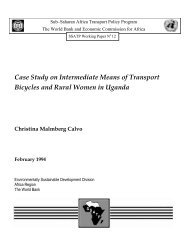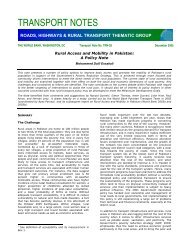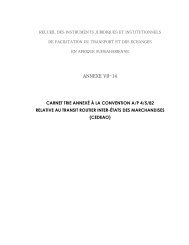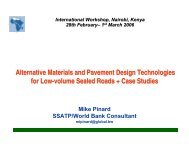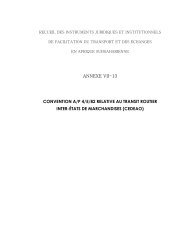Urban Transport - World Bank
Urban Transport - World Bank
Urban Transport - World Bank
You also want an ePaper? Increase the reach of your titles
YUMPU automatically turns print PDFs into web optimized ePapers that Google loves.
level and define the coordination arrangements with in particular the central or local<br />
governments but also other central/local institutions involved in urban transport.<br />
On the other side, some level of integration between urban transport management and other<br />
municipal functions is also necessary. Land-use management, stormwater drainage, road<br />
maintenance are important municipal functions with a significant amount of interaction with<br />
urban mobility. The vision for urban transport and the legal instruments should specify and detail<br />
the type of functions which should be integrated.<br />
The participants generally agreed on urban transport authority as a model for the lead institution<br />
for urban transport. However, the authority needs to reflect in the legal instruments for its<br />
creation, the vision, the need for coordination and the level of integration (Tanzania model of<br />
steering committee, CETUD model in Senegal with participation of central government, local<br />
government and private sector). The model of LAMATA in Nigeria was given as successful in<br />
working with local authorities to develop the BRT system, while Tanzania developed a vision for<br />
urban transport before LAMATA was created but was unable to develop the proposed BRT in<br />
the absence of an urban transport authority able to coordinate implementation of the vision.<br />
Participants pointed out the need to make a distinction between capital cities and secondary<br />
cities. Capital cities present the additional challenge of giving a greater political visibility to<br />
urban mobility. It may be easier to develop institutional frameworks for secondary cities which<br />
in turn could become model for capital cities.<br />
A critical condition of success and sustainability of the urban mobility framework is the capacity<br />
of urban transport institutions to communicate with politicians. The participants to the meeting<br />
recognized the communication gap with urban transport institutions unable to respond to the<br />
concerns from the politicians. While politicians are interested in satisfying the demand for<br />
mobility from urban dwellers or in the ways their actions impact on economic growth and<br />
poverty alleviation of urban households, urban transport institutions have not been able to<br />
communicate on the link between urban transport mobility programs and these concerns or on<br />
how the institutional framework is appropriate to address these concerns.<br />
Implementing these strategic orientations require adapting to the level of readiness of countries<br />
to promote urban mobility and adopt appropriate institutional frameworks. The participants<br />
identified three main levels of readiness:<br />
- Countries which have already made progress in implementing these orientations, such as<br />
South Africa, Senegal and Liberia;<br />
- Countries which are aware of urban mobility issues and interested in taking actions but<br />
are uncertain on the way forward;<br />
- Countries which are unwilling to take actions either because they are not informed or<br />
because they are not interested.<br />
The meeting recommended that SSATP identify strategies to facilitate development of urban<br />
transport policies adapted to each case of readiness and pilot these strategies in countries as<br />
examples from which other countries could learn to develop their own strategies. SSATP was<br />
encouraged to implement these pilots using a system involving peer countries building on the<br />
network of urban transport practitioners in Africa.<br />
4





